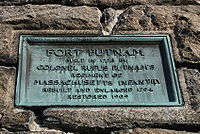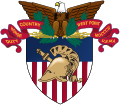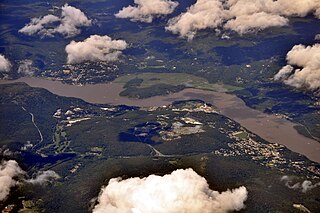
West Point is the oldest continuously occupied military post in the United States. Located on the Hudson River in New York, West Point was identified by General George Washington as the most important strategic position in America during the American Revolution. Until January 1778, West Point was not occupied by the military. On January 27, 1778, Brigadier General Samuel Holden Parsons and his brigade crossed the ice on the Hudson River and climbed to the plain on West Point and from that day to the present, West Point has been occupied by the United States Army. It comprises approximately 16,000 acres (6,500 ha) including the campus of the United States Military Academy, which is commonly called "West Point".

Marietta is a city in, and the county seat of, Washington County, Ohio, United States. It is located in southeastern Ohio at the confluence of the Muskingum and Ohio Rivers, 11 miles (18 km) northeast of Parkersburg, West Virginia. As of the 2020 census, Marietta has a population of 13,385 people and is the principal city of the Marietta Micropolitan Statistical Area, which includes all of Washington County, and is the second-largest city in the Parkersburg–Marietta–Vienna, WV–OH Combined Statistical Area.

The Battle of Bunker Hill was fought on Saturday June 17, 1775 during the Siege of Boston in the first stage of the American Revolutionary War. The battle is named after Bunker Hill in Charlestown, Massachusetts, which was peripherally involved in the battle. It was the original objective of both the colonial and British troops, though the majority of combat took place on the adjacent hill which later became known as Breed's Hill.

The Northwest Territory, also known as the Old Northwest and formally known as the Territory Northwest of the River Ohio, was formed from unorganized western territory of the United States after the American Revolutionary War. Established in 1787 by the Congress of the Confederation through the Northwest Ordinance, it was the nation's first post-colonial organized incorporated territory.

Fort William Henry was a British fort at the southern end of Lake George, in the province of New York. The fort's construction was ordered by Sir William Johnson in September 1755, during the French and Indian War, as a staging ground for attacks against the French position at Fort St. Frédéric. It was part of a chain of British and French forts along the important inland waterway from New York City to Montreal, and occupied a key forward location on the frontier between New York and New France. In 1757, the French general Louis-Joseph de Montcalm conducted a successful siege that forced the British to surrender. The Huron warriors who accompanied the French army subsequently killed many of the British prisoners. The siege and massacre were famously portrayed in James Fenimore Cooper's novel The Last of the Mohicans.
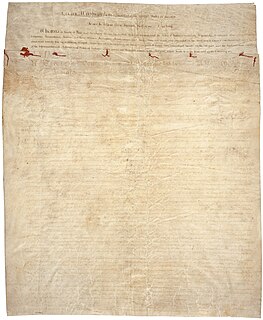
The Treaty of Greenville, formally titled Treaty with the Wyandots, etc., was a 1795 treaty between the United States and indigenous nations of the Northwest Territory, including the Wyandot and Delaware peoples, that redefined the boundary between indigenous peoples' lands and territory for European American community settlement.

Rutland is a town in Worcester County, Massachusetts, United States. The population was 9,049 at the 2020 census. Rutland is the geographic center of Massachusetts; a tree, the Central Tree, located on Central Tree Road, marks the general spot.

The Battle of White Plains was a battle in the New York and New Jersey campaign of the American Revolutionary War, fought on October 28, 1776 near White Plains, New York. Following the retreat of George Washington's Continental Army northward from New York City, British General William Howe landed troops in Westchester County, intending to cut off Washington's escape route. Alerted to this move, Washington retreated farther, establishing a position in the village of White Plains but failed to establish firm control over local high ground. Howe's troops drove Washington's troops from a hill near the village; following this loss, Washington ordered the Americans to retreat farther north.

The Battle of Stony Point took place on July 16, 1779, during the American Revolutionary War. In a well-planned and -executed nighttime attack, a highly trained select group of George Washington's Continental Army troops under the command of Brigadier General "Mad Anthony" Wayne defeated British troops in a quick and daring assault on their outpost in Stony Point, New York, approximately 30 mi (48 km) north of New York City.

Fort Greene Park is a city-owned and -operated park in Fort Greene, Brooklyn, New York City. The 30.2-acre (12.2 ha) park was originally named after the fort formerly located there, Fort Putnam, which itself was named for Rufus Putnam, George Washington's Chief of Engineers in the Revolutionary War. Renamed in 1812 for Nathanael Greene, a hero of the American Revolutionary War, it was redesigned by Frederick Law Olmsted and Calvert Vaux, who also designed Central Park and Prospect Park, in 1867. The park contains the Prison Ship Martyrs' Monument, which includes a crypt designed by Olmsted and Vaux.
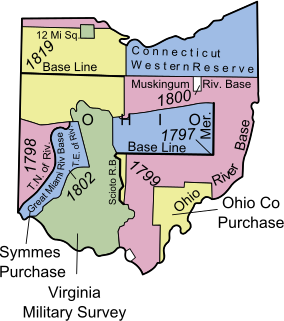
The Ohio Company of Associates, also known as the Ohio Company, was a land company whose members are today credited with becoming the first non-Native American group to permanently settle west of the Allegheny mountains. In 1788 they established Marietta, Ohio, as the first permanent settlement of the new United States in the newly organized Northwest Territory.

Brigadier-General Rufus Putnam was a colonial military officer during the French and Indian War, and a general in the Continental Army during the American Revolutionary War. As an organizer of the Ohio Company of Associates, he was instrumental in the initial settling of the Northwest Territory in present-day Ohio following the war.

Fort Crown Point was a British fort built by the combined efforts of both British and provincial troops in North America in 1759 at a narrows on Lake Champlain on what later became the border between New York and Vermont. Erected to secure the region against the French, the fort is in upstate New York near the town of Crown Point and was the largest earthen fortress built in the United States. The fort's ruins, a National Historic Landmark, are now administered as part of Crown Point State Historic Site.

The General Israel Putnam House in Danvers, Massachusetts, United States, is a historic First Period house recorded in the National Register of Historic Places. The house is also sometimes known as the Thomas Putnam House after Lt. Thomas Putnam (1615–1686), who built the home circa 1648. His grandson, Israel Putnam, the famous general of the American Revolution, was born in the house. Lt. Thomas Putnam was the father of Sgt. Thomas Putnam Jr.,, a notorious figure in the Salem witch trials. The Putnam House is now owned by the Emerson Family, the same owners of Putnam Pantry.

The General Rufus Putnam House is a National Historic Landmark at 344 Main Street in Rutland, Worcester County, Massachusetts, US.

Constitution Island is located on the east side of the Hudson River directly opposite the U.S. Military Academy Reservation and is connected to the east shore by Constitution Marsh.

Fort Clinton was an American Revolutionary War fort located near West Point, New York. Commanded by and named after Benedict Arnold before his betrayal of the United States and defection to the British Army, the fortification was renamed after General James Clinton.

Kościuszko's Monument is a pedestal and statue of Polish General Tadeusz Kościuszko at the United States Military Academy at West Point, New York. Kościuszko designed the defenses of the West Point garrison from 1778–1780 during the height of the Revolutionary War, when George Washington considered West Point to be the most important military post in America. The pedestal and shaft of the monument was first proposed in 1825 by John Latrobe, and dedicated in 1828. The statue, designed by D. Borja, was later added in 1913.

The Rufus Putnam House, also known as Campus Martius or Campus Martius Museum State Memorial, is a historic building in Marietta, Ohio. It was built as part of the Campus Martius fortification by General Rufus Putnam, during the early settlement of Ohio by the Ohio Company of Associates.

Redoubt Four was a supporting defensive position of Fort Putnam during the Revolutionary War defensive network at West Point. It was constructed under the command of Tadeusz Kosciuszko in 1778-1779. During the war, it was a key defensive overwatch position for Fort Putnam 300 feet below, which was in turn the key overwatch position for Fort Clinton. According to Benedict Arnold, the fort required approximately 100 soldiers to man it. The redoubt was partially restored in 1975-1976 as part of the bicentennial celebration. It can be accessed by foot year round from Patrick Trail (road) approximately .5 miles from the West Point Post Exchange complex.

